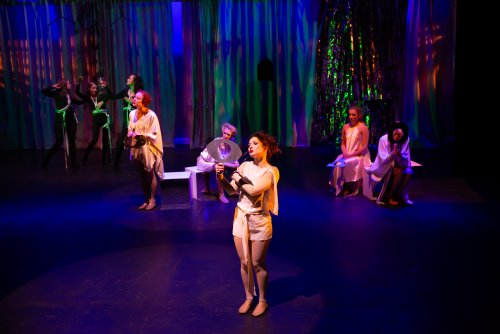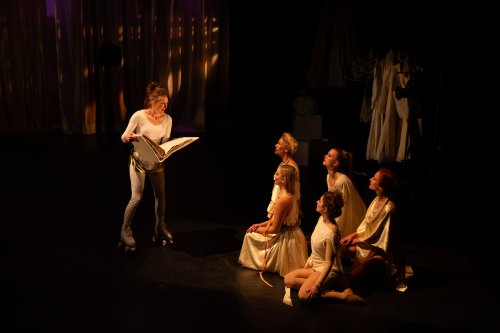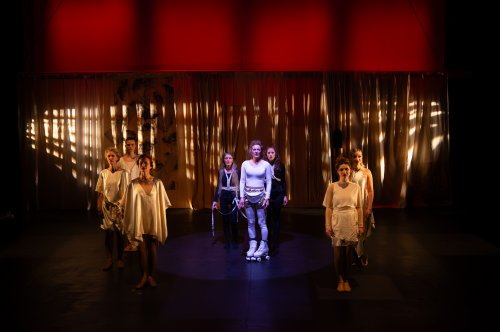Lists of Promise
An exploration of the subjugation and liberation of women through history, a multimedia theater piece inspired by "When God Was a Woman" by Merlin Stone.

A scene from “Lists of Promise” at Theater for the New City (Photo credit: @nonartbyJudit Judit Sipos)
Consider, if you will, a flow of time encompassing mythic structures defining the psychological nature of social order and gender roles. Stories, songs, and dances create a world where mythic structures become semi-rigid and fixed for hundreds, if not thousands, of years. It is a world where one thought type appears to dominate all other types by coercive means, including brute force. It is a world defined by men without consideration for anyone or anything other than themselves.
Lists of Promise is an exploration of the subjugation and liberation of women through history created by Ildiko Nemeth and Lisa Giobbi with Marie Glancy O’Shea. It is an avant-garde theater piece inspired by When God Was a Woman by Merlin Stone. It combines classical theater with choreography, both grounded and aerial, following a group of women across time periods and societal structures, illuminating the things that have come to define a woman’s place in history and the social order. Giobbi’s choreography, especially the aerial, is an unexpected and solid addition to the show.
Nemeth directs a cast of nine women and one man in a series of vignettes combining storytelling and the mundane aspects of daily life with humor and introspection to expose questions surrounding the expectations placed on women.

A scene from “Lists of Promise” at Theater for the New City (Photo credit: @nonartbyJudit Judit Sipos)
The audience enters the theater 15 minutes before the curtain rises, while five women stand like statues upstage along a wall of curtains. A sixth woman roller skates throughout the performance area, at times close to the audience and then to the women at the curtains. It is an intriguing nonverbal prologue that immerses the audience in a mystery of what is to come.
The lights dim, and the women at the curtains move towards center stage, speaking lines without an apparent connection to each other, forming the verbal prologue. They are referred to as Grounded Women (GW) in the script and are the Greek chorus to the narrative “call” supplied by the skater known as Contemporary Woman (CW). Each response to a call can be seen as a list of things related to the call and, in this case, things said to and about women in many different contexts.
Once the nature of the CW and GW is established, the CW begins to provide the historical things that led to the definition of woman in the contemporary world in all its manifestations. CW opens a book and says, “Once upon a time, when the Earth was still empty and very dusty, for lo, there was no one there to keep house, the Lord God took some of that dust from the ground, and made a man: Adam.”

A scene from “Lists of Promise” at Theater for the New City (Photo credit: @nonartbyJudit Judit Sipos)
As she speaks, a man appears in an aerial harness, floating above the stage in front of the curtain wall. This dance element adds a new dimension to the choreography of the Grounded Women, who, in the opening sequence, operate as a dance ensemble. As CW continues with her narrative, the moment arrives when Eve is created, at which point a woman in an aerial harness appears. The two aerial dancers interact in concert, and CW speaks the narrative.
CW’s narrative leads to the point where Adam and Eve are cast from the Garden of Eden, with Eve being marked as the cause of the event. Adam, the aerial movements being masterfully supplied by Jacob McKee, is enraged at Eve. The GW provides the invectives Adam is hurling at Eve, the result of which is a list of rules. CW recites the list imposed by Adam, a man, on Eve, a woman, and by extension, on all women over time.
The scene with Adam and Eve establishes the structure for the show, with each of the ensuing vignettes being conducted in a call-and-response format. The second explores a list of rules established during the Victorian Era. In this set, the aerial performers represent a young girl just coming of age and two older, more established women. The aerial characters make the call with the response coming from different members of the Grounded Women, each expanding on the list of comments being made by the aerialists. The set ends with the Contemporary Woman bringing together some of the ideas presented in the call and response, presenting the state of a woman’s status in society as the result of the list of rules.

A scene from “Lists of Promise” at Theater for the New City (Photo credit: @nonartbyJudit Judit Sipos)
The next two vignettes extend the narrative of the social definition of women; one is how women are perceived in a legal context, and the other is a modern depiction of social interaction bordering on fantasy. The staging with the two main ensemble components of the Grounded Women and the aerialists could be seen as a distraction in less skilled hands. However, it is well integrated with the dialogue, and the dialogue is the key element of all the vignettes with a clear avant-garde feel to them. The text has a poetic tone while delivering important points regarding the status of women over the centuries, demonstrating that although things have improved, more still needs to be done.
The ensemble’s characterizations are generally solid, with some unevenness in the early part of the show, but as the piece progressed, the performances became better integrated. The ensemble is composed of Sarah Lemp, Lisa Giobbi, Rebecca Magazine, Lainey McKinnon, Tatjana Kot, Renee Erikson, Amanda Langberg Hermansen, Elena Lozonschi, Elizabeth Foster, and Jacob McKee.
The costumes are another element adding to the avant-garde nature of the production. The costumes Tamar Mogendorff created in collaboration with Jessica Mitrani effectively define the characters in the different vignettes. The Grounded Women wear variations on diaphanous dresses reminiscent of costumes seen on Greek and Roman statues, including those of the Contemporary Woman. The aerial dancer’s costumes are distinctly different from the others but still effectively define the characters. Mogendorff is also the set designer of the minimalist sets that work well in the production.
Federico Restrepo’s lighting design does an excellent job of highlighting and integrating the aerial choreography with the grounded elements. Dalton Shavez’s sound engineering adds an essential component to the integration of the diverse aspects of the show. The effectiveness of the aerial choreography would not be possible without the solid work of Benny Oyzone, Abe Meisel, Jacob McKee, and Manny Mendoza.
Lists of Promise (through March 30, 2025)
New Stage Theatre Company & Lisa Giobbi Movement Theatre
Theater for the New City, 155 First Avenue, in Manhattan.
For tickets, call 212-254-1109 or visit
www.theaterforthenewcity.net/shows/lists-of-promise/
Running time: 90 minutes without an intermission






Leave a comment